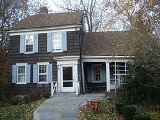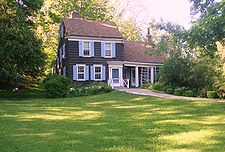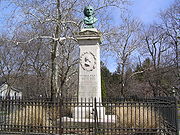
Thomas Paine Cottage
Encyclopedia
The Thomas Paine Cottage in New Rochelle
, New York
in the United States
, was the home from 1802 to 1806 of Thomas Paine
, author of Common Sense
and Revolutionary War
hero. Paine was buried near the cottage from his death in 1809 until his body was disinterred in 1819. The cottage has been owned by the Huguenot and New Rochelle Historical Association and has been operated as a historic house museum since 1910. It was declared a National Historic Landmark
on November 28, 1972.
saltbox
structure. It began as a simple building 16 feet (4.9 m) wide and 31 feet (9.4 m) deep. In 1804, an additional 18 by wing with a porch was constructed. An exterior door and porch pillars in the Greek Revival style were added in about 1830.
The house has a kitchen, a common room, and a bedroom on the main floor, with a parlor in the wing. On the second floor are four bedrooms.
 The 277 acres (112.1 ha) farm was originally owned by the Tory
The 277 acres (112.1 ha) farm was originally owned by the Tory
Frederick Davoue, but was confiscated after the war. 320 acres (129.5 ha) including the farm were presented to Paine in 1784 by act of the New York State Legislature for his service. The stone house occupied by Davoue was destroyed by fire in 1793 and replaced with the cottage while Paine was in Europe
.
The Huguenot Association acquired the house from Charles See, who wanted to subdivide the property for real estate development. It was moved approximately 440 yards west to its current location at 20 Sicard Avenue in 1908. This is the last extant portion of the farm owned by Paine.
. The organization, founded in 1905, is not connected either to the cottage or to the Huguenot and New Rochelle Historical Association. In 2005, the association controversially sold off a significant portion of its holdings (including a first edition of Common Sense) to pay for repairs to the museum building.
 The creation of the Thomas Paine monument was organized and carried to completion by Paine biographer and radical New York publisher, educator, and reformer Gilbert Vale. Vale's fellow American radical and Workingman, the sculptor and architect John Frazee, created the marble monument itself. An 1881 bronze bust of Paine by Wilson McDonald was later added. It was moved next to the current location of the cottage in 1905. It is owned by the city of New Rochelle.
The creation of the Thomas Paine monument was organized and carried to completion by Paine biographer and radical New York publisher, educator, and reformer Gilbert Vale. Vale's fellow American radical and Workingman, the sculptor and architect John Frazee, created the marble monument itself. An 1881 bronze bust of Paine by Wilson McDonald was later added. It was moved next to the current location of the cottage in 1905. It is owned by the city of New Rochelle.
removed Paine's remains to England to build a larger memorial, but Cobbett died before succeeding and the remains disappeared. Dr. Moncure D. Conway claimed to have recovered a portion of Paine's brain around 1905; it was subsequently buried under the monument on October 14, 1905. The search for portions of Paine's body continues; in 2001, DNA
tests were proposed for a portion of what was claimed to be his skull.
Indians, and the Huguenots. Highlights of the house include a chair owned by Paine as well as a cast iron Franklin stove
presented to Paine by its inventor.
The Sophia Brewster One-Room Schoolhouse, the oldest private school in New Rochelle, was also moved to the property.
The cottage and schoolhouse are open to the public five days a week. There are several weekend events scheduled at the cottage throughout the year. In addition, the cottage hosts many local school field trips. It had 3,000 visitors in 2002.
New Rochelle, New York
New Rochelle is a city in Westchester County, New York, United States, in the southeastern portion of the state.The town was settled by refugee Huguenots in 1688 who were fleeing persecution in France...
, New York
New York
New York is a state in the Northeastern region of the United States. It is the nation's third most populous state. New York is bordered by New Jersey and Pennsylvania to the south, and by Connecticut, Massachusetts and Vermont to the east...
in the United States
United States
The United States of America is a federal constitutional republic comprising fifty states and a federal district...
, was the home from 1802 to 1806 of Thomas Paine
Thomas Paine
Thomas "Tom" Paine was an English author, pamphleteer, radical, inventor, intellectual, revolutionary, and one of the Founding Fathers of the United States...
, author of Common Sense
Common Sense (pamphlet)
Common Sense is a pamphlet written by Thomas Paine. It was first published anonymously on January 10, 1776, during the American Revolution. Common Sense, signed "Written by an Englishman", became an immediate success. In relation to the population of the Colonies at that time, it had the largest...
and Revolutionary War
American Revolutionary War
The American Revolutionary War , the American War of Independence, or simply the Revolutionary War, began as a war between the Kingdom of Great Britain and thirteen British colonies in North America, and ended in a global war between several European great powers.The war was the result of the...
hero. Paine was buried near the cottage from his death in 1809 until his body was disinterred in 1819. The cottage has been owned by the Huguenot and New Rochelle Historical Association and has been operated as a historic house museum since 1910. It was declared a National Historic Landmark
National Historic Landmark
A National Historic Landmark is a building, site, structure, object, or district, that is officially recognized by the United States government for its historical significance...
on November 28, 1972.
Description
The cottage is a two-story wood-frameFraming (construction)
Framing, in construction known as light-frame construction, is a building technique based around structural members, usually called studs, which provide a stable frame to which interior and exterior wall coverings are attached, and covered by a roof comprising horizontal ceiling joists and sloping...
saltbox
Saltbox
A saltbox is a building with a long, pitched roof that slopes down to the back, generally a wooden frame house. A saltbox has just one story in the back and two stories in the front...
structure. It began as a simple building 16 feet (4.9 m) wide and 31 feet (9.4 m) deep. In 1804, an additional 18 by wing with a porch was constructed. An exterior door and porch pillars in the Greek Revival style were added in about 1830.
The house has a kitchen, a common room, and a bedroom on the main floor, with a parlor in the wing. On the second floor are four bedrooms.
History

Loyalist (American Revolution)
Loyalists were American colonists who remained loyal to the Kingdom of Great Britain during the American Revolutionary War. At the time they were often called Tories, Royalists, or King's Men. They were opposed by the Patriots, those who supported the revolution...
Frederick Davoue, but was confiscated after the war. 320 acres (129.5 ha) including the farm were presented to Paine in 1784 by act of the New York State Legislature for his service. The stone house occupied by Davoue was destroyed by fire in 1793 and replaced with the cottage while Paine was in Europe
Europe
Europe is, by convention, one of the world's seven continents. Comprising the westernmost peninsula of Eurasia, Europe is generally 'divided' from Asia to its east by the watershed divides of the Ural and Caucasus Mountains, the Ural River, the Caspian and Black Seas, and the waterways connecting...
.
The Huguenot Association acquired the house from Charles See, who wanted to subdivide the property for real estate development. It was moved approximately 440 yards west to its current location at 20 Sicard Avenue in 1908. This is the last extant portion of the farm owned by Paine.
Museum
Located adjacent to the cottage is a 1925 museum dedicated to Paine created by the Thomas Paine National Historical AssociationThomas Paine National Historical Association
The Thomas Paine Historical Association is an organization based in New Rochelle, New York, that is dedicated to perpetuating the legacy of Founding Father Thomas Paine. It was organized on the anniversary of Thomas Paine's birthday, January 29, 1884, and is one of the oldest historical...
. The organization, founded in 1905, is not connected either to the cottage or to the Huguenot and New Rochelle Historical Association. In 2005, the association controversially sold off a significant portion of its holdings (including a first edition of Common Sense) to pay for repairs to the museum building.
Monument

Burial
Paine was buried near the current location of the house and monument in 1809 after dying in Greenwich Village, New York. He wanted to be buried in the Quaker cemetery but, due to his writings, he was refused. His few remaining friends walked his body to New Rochelle and buried him on his property. In 1819, the English radical William CobbettWilliam Cobbett
William Cobbett was an English pamphleteer, farmer and journalist, who was born in Farnham, Surrey. He believed that reforming Parliament and abolishing the rotten boroughs would help to end the poverty of farm labourers, and he attacked the borough-mongers, sinecurists and "tax-eaters" relentlessly...
removed Paine's remains to England to build a larger memorial, but Cobbett died before succeeding and the remains disappeared. Dr. Moncure D. Conway claimed to have recovered a portion of Paine's brain around 1905; it was subsequently buried under the monument on October 14, 1905. The search for portions of Paine's body continues; in 2001, DNA
DNA
Deoxyribonucleic acid is a nucleic acid that contains the genetic instructions used in the development and functioning of all known living organisms . The DNA segments that carry this genetic information are called genes, but other DNA sequences have structural purposes, or are involved in...
tests were proposed for a portion of what was claimed to be his skull.
Today
The current arrangement has rooms decorated in the late 18th and early 19th century style as well as exhibits pertaining to the history of New Rochelle, the local SiwanoySiwanoy
The Native American Siwanoy or Sinanoy were a band of Algonquian-speaking people, the Wappinger, in what is now the New York City area. By the mid-17th century, when their territory became hotly contested between Dutch and English colonial interests, the Siwanoy were settled along the East River...
Indians, and the Huguenots. Highlights of the house include a chair owned by Paine as well as a cast iron Franklin stove
Franklin stove
The Franklin stove is a metal-lined fireplace named after its inventor, Benjamin Franklin. It was invented in 1741.L.W. Labaree, W. Bell, W.B. Willcox, et al., eds., The Papers of Benjamin Franklin , vol. 2, page 419...
presented to Paine by its inventor.
The Sophia Brewster One-Room Schoolhouse, the oldest private school in New Rochelle, was also moved to the property.
The cottage and schoolhouse are open to the public five days a week. There are several weekend events scheduled at the cottage throughout the year. In addition, the cottage hosts many local school field trips. It had 3,000 visitors in 2002.
External links
- Thomas Paine Cottage
- Thomas Paine House: 1 photo, at Historic American Buildings SurveyHistoric American Buildings SurveyThe Historic American Buildings Survey , Historic American Engineering Record , and Historic American Landscapes Survey are programs of the National Park Service established for the purpose of documenting historic places. Records consists of measured drawings, archival photographs, and written...

